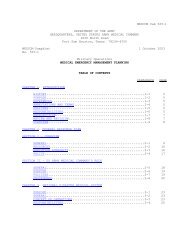(MCD) Guidelines
(MCD) Guidelines
(MCD) Guidelines
Create successful ePaper yourself
Turn your PDF publications into a flip-book with our unique Google optimized e-Paper software.
<strong>Guidelines</strong> for Military Mass Casualty Decontamination Operations<br />
During a Domestic HAZMAT/Weapon of Mass Destruction Incident<br />
Technology Capabilities Limitations<br />
Radiological Detectors<br />
Geiger-Mueller • Detects alpha, beta, and gamma<br />
radiation depending on probe being<br />
used.<br />
• Measures dose and dose rate.<br />
Ion Chamber • Primarily detects gamma and highenergy<br />
beta radiation.<br />
• Measures dose and dose rate.<br />
• Becomes saturated in high radiation<br />
environments.<br />
• Uses high voltages to operate, so it is<br />
not intrinsically safe.<br />
• Does not detect alpha radiation.<br />
• Requires annual calibration at offsite<br />
facility.<br />
There is considerable reference material available to responders that can be used in<br />
the interpretation of data, including (but not limited to):<br />
• U.S. Department of Transportation (DOT) Emergency Response Guidebook<br />
(ERG) 42<br />
• National Institute of Occupational Safety and Health (NIOSH) Pocket Guide to<br />
Chemical Hazards 43<br />
• U.S. Coast Guard (USCG) Chemical Hazards Response Information System<br />
(CHRIS) Manual and Hazard Assessment Computer System<br />
• Various suites of free HAZMAT software. Example software includes Areal<br />
Location of Hazardous Atmospheres model (ALOHA); Computer-Aided<br />
Management of Emergency Operations (CAMEO); and Mapping Application for<br />
Response, Planning and Local Operational Tasks (MARPLOT)<br />
• Various suites of commercially available HAZMAT software, such as CoBRA<br />
• Consequence Assessment Tool Set with Joint Assessment of Catastrophic<br />
Events (CATS-JACE) from the Defense Threat Reduction Agency, U.S. Army<br />
• Joint Warning and Reporting Network (JWARN) from the Joint Program Executive<br />
Office for Chemical and Biological Defense, U.S. Army<br />
• Wireless Information System for Emergency Responders (WISER) from the U.S.<br />
National Library of Medicine, National Institutes of Health and the Department of<br />
Health and Human Services<br />
• Manufacturer-provided material safety data sheets (MSDSs)<br />
• Shipping papers, bills of lading, and/or manifests<br />
Additional tools and information on detection and surveillance methods to identify<br />
agents are provided in Appendix D and Appendix E.<br />
6.3 Individual and Personal Protective Equipment<br />
The Incident Commander establishes the appropriate protective posture based on<br />
information gained during survey and monitoring reconnaissance operations. PPE<br />
guidance can be found in the product or agent’s MSDS, DOT ERG, 42 and/or NIOSH<br />
Pocket Guide. 43 All personnel who may be directly or indirectly exposed must don<br />
appropriate PPE. Or, they should follow at least the minimum level of protective<br />
measures required. Mission-oriented protective posture (MOPP) gear available to<br />
military personnel is IPE and is categorized into four ensembles: 13,44<br />
16 Original



